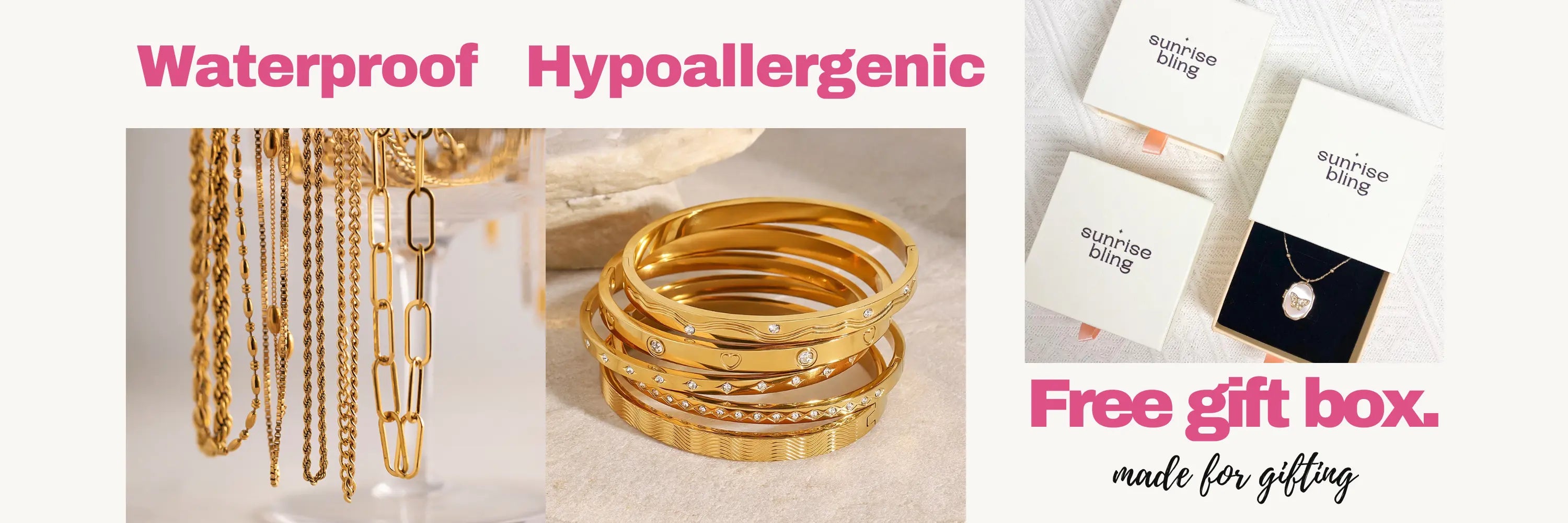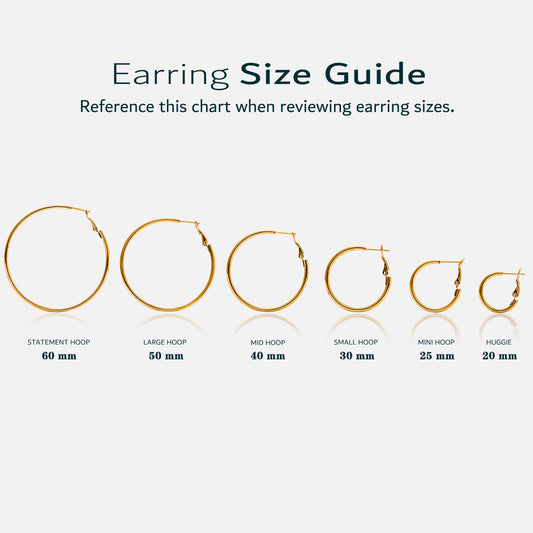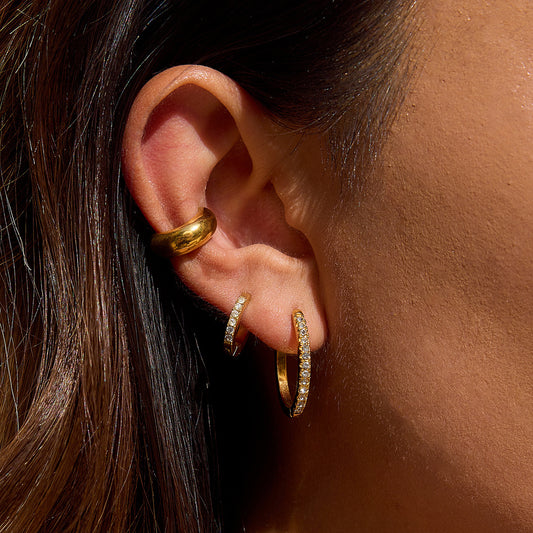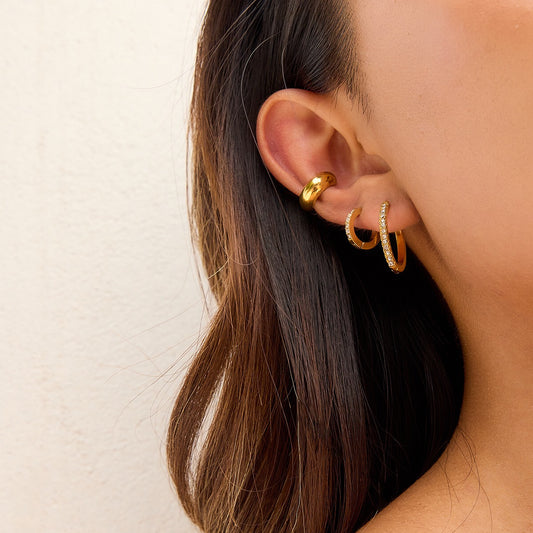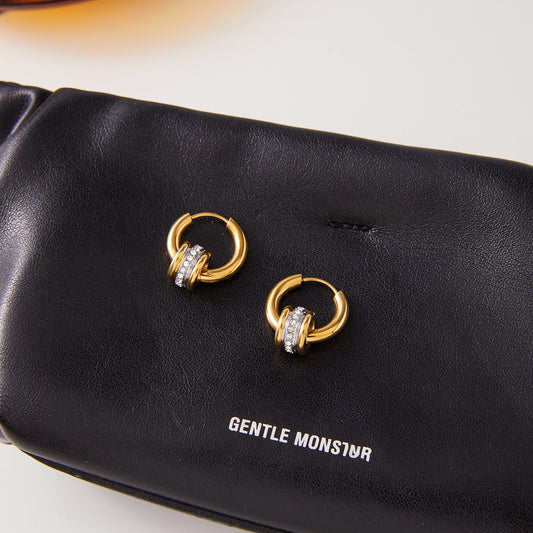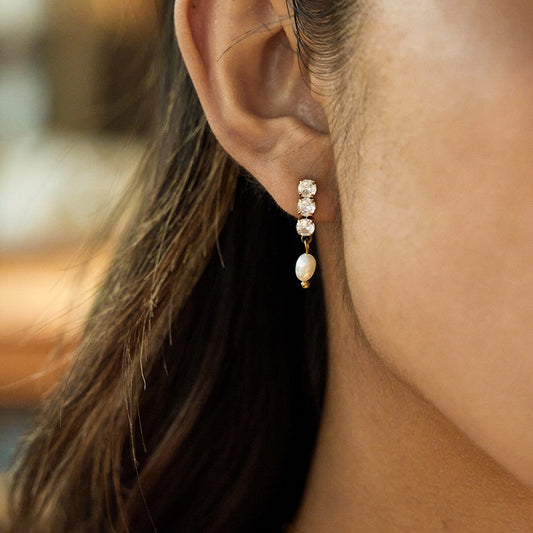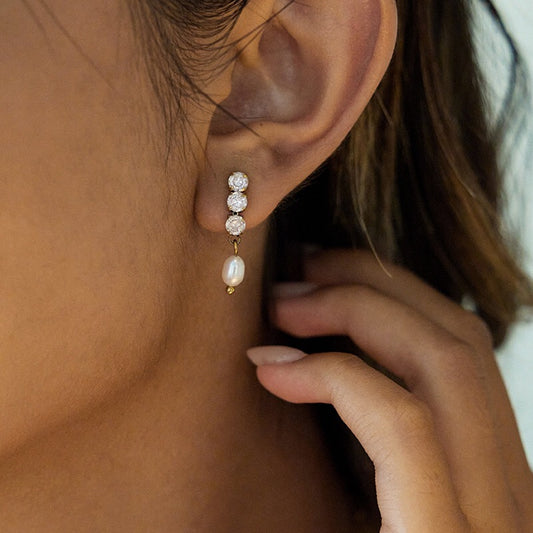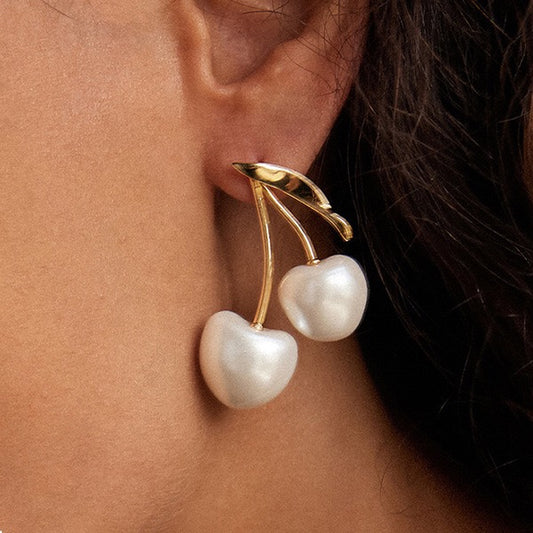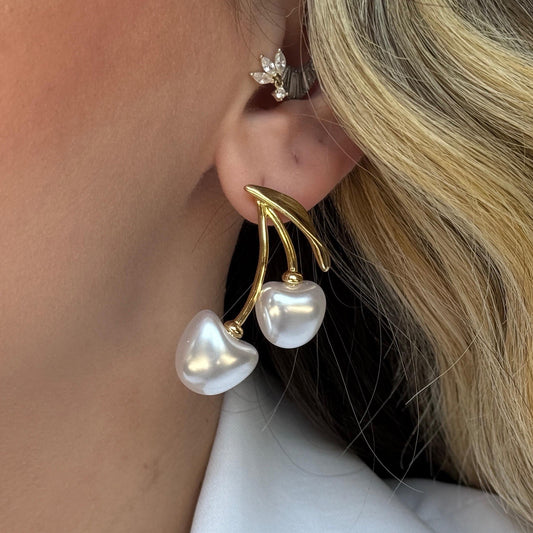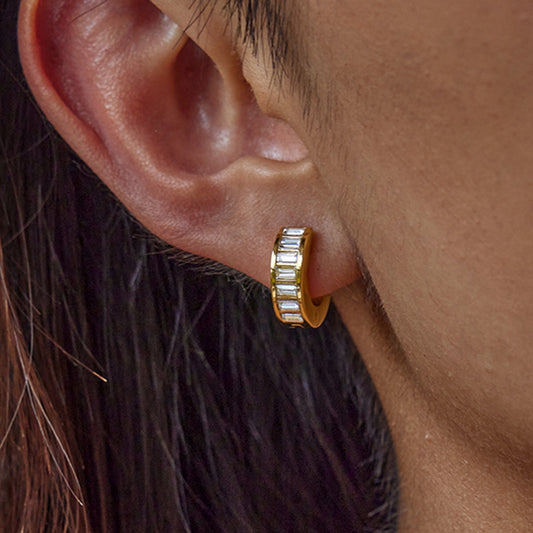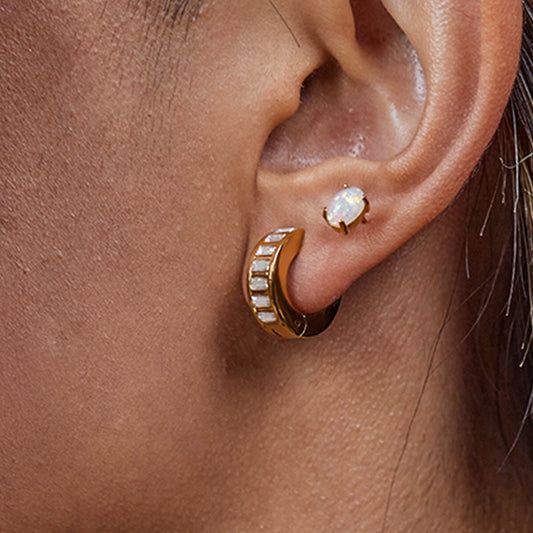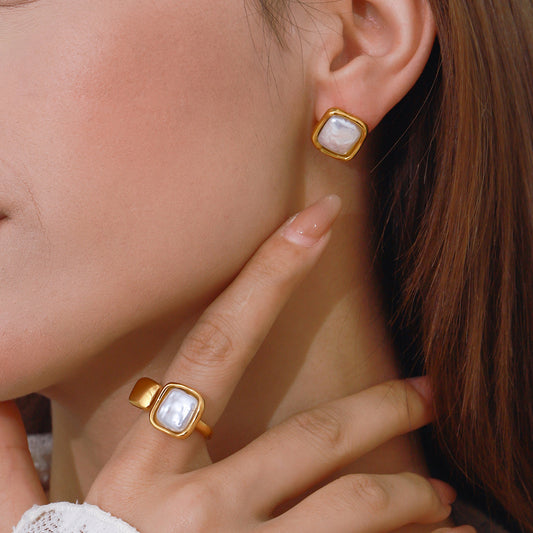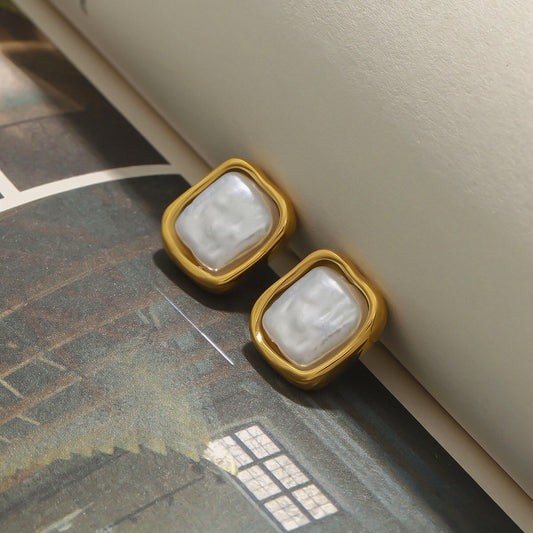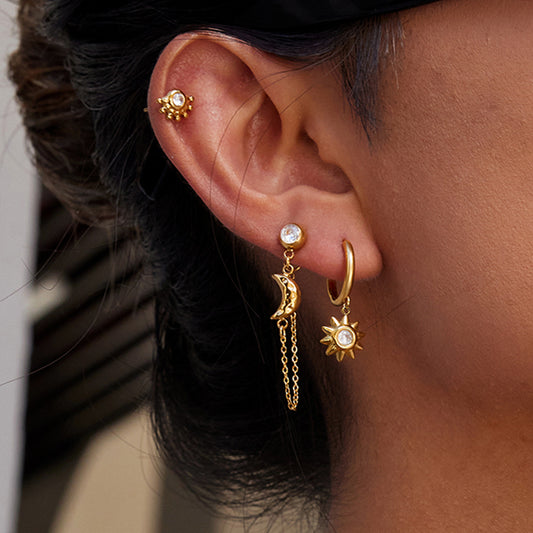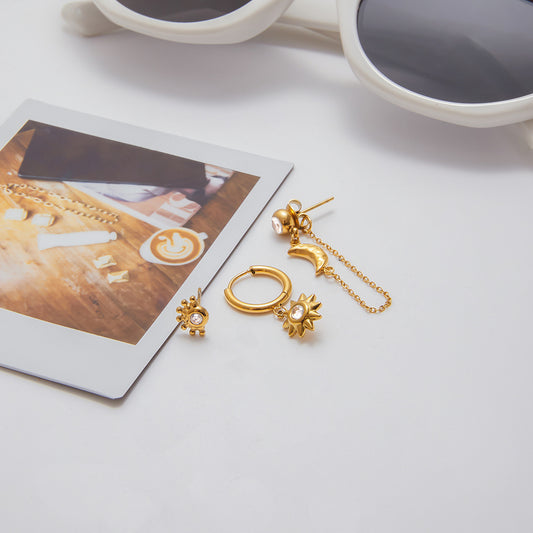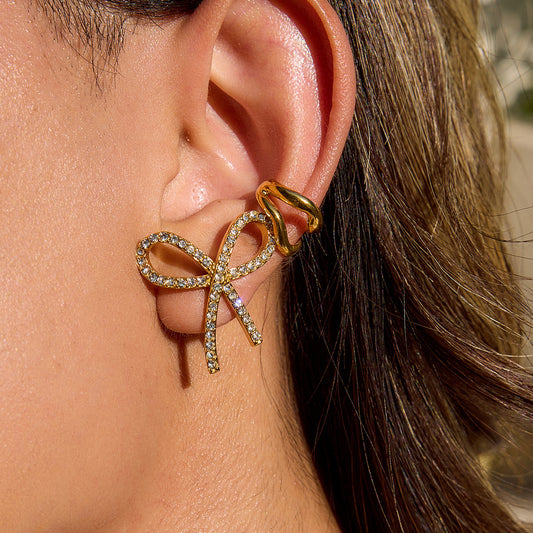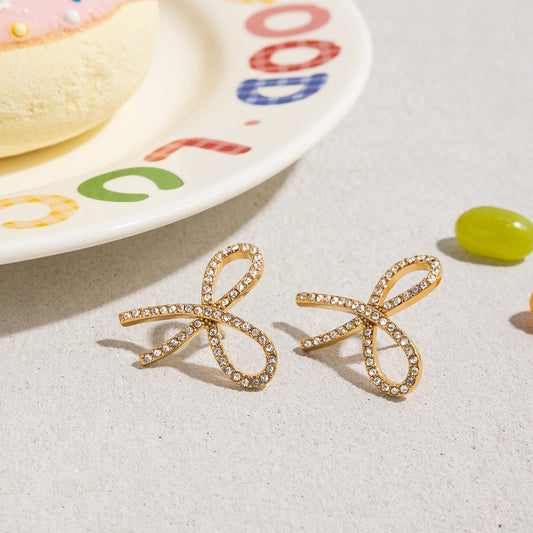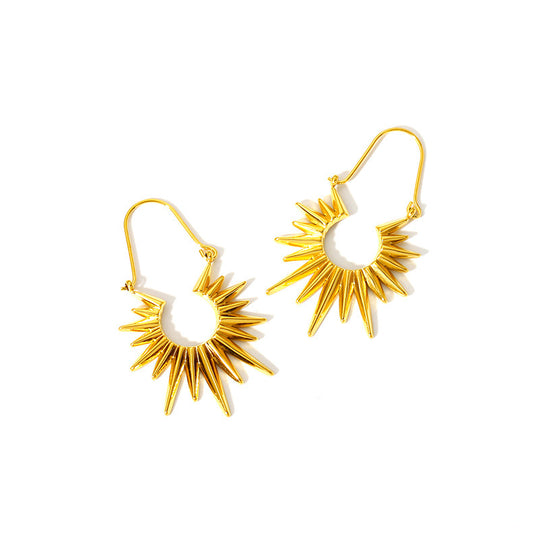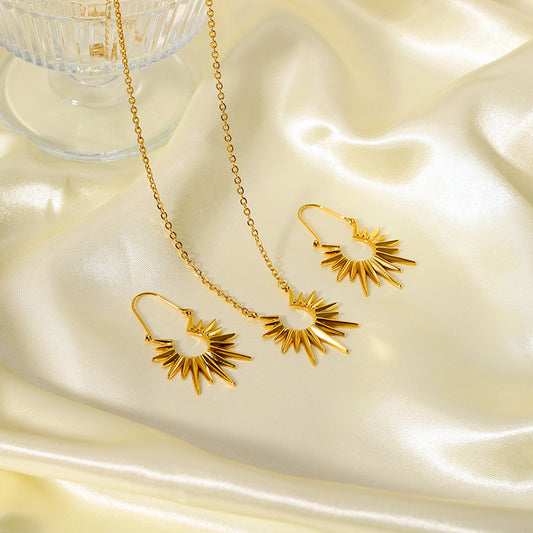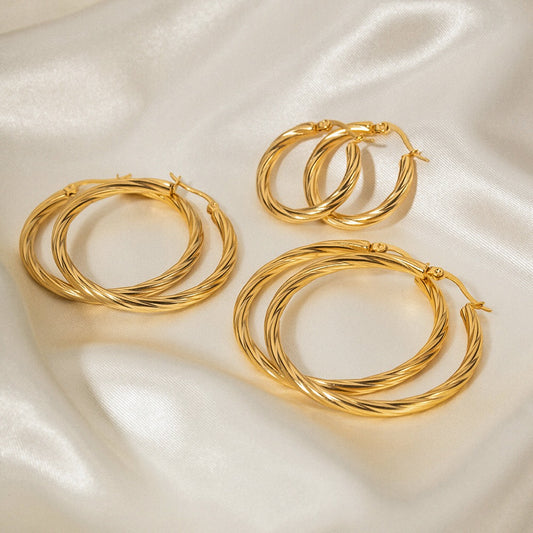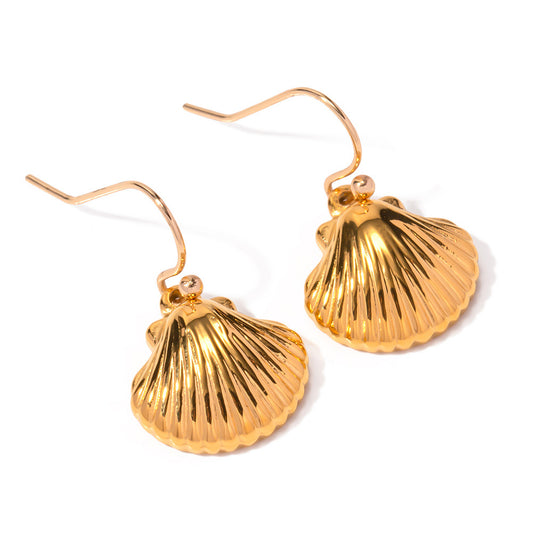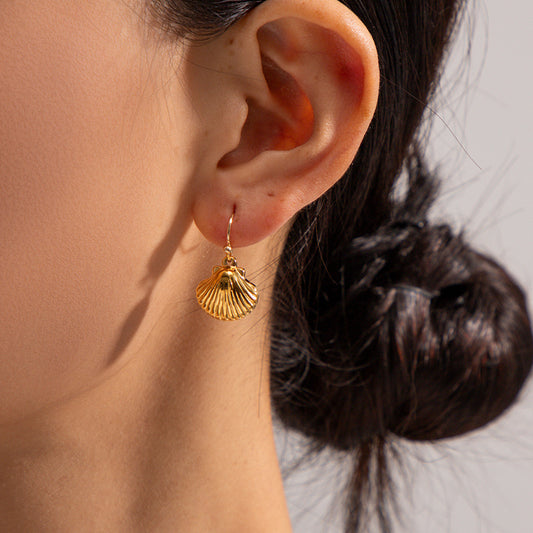Flatback earrings have become a game-changer for anyone who loves ear jewelry but struggles with discomfort or irritation—especially those with sensitive piercings or cartilage piercings. The global jewelry market size was estimated at USD 366.79 billion in 2024 and is projected to reach USD 578.45 billion by 2033, growing at a CAGR of 5.3%. The reason for their boom? Unlike traditional earrings with protruding backs (which dig into skin, snag on hair, or irritate sensitive lobes), flatback earrings feature a smooth, flush backing that sits entirely against the ear. This design solves the biggest pain points of everyday ear jewelry—discomfort and practicality—without sacrificing style. Whether you’re rocking a single stud in your lobe or a stack in your cartilage, flatback earrings deliver the sparkle you want with the comfort you need. This guide covers everything you need to know about flatback earrings, from their design to how to care for them.
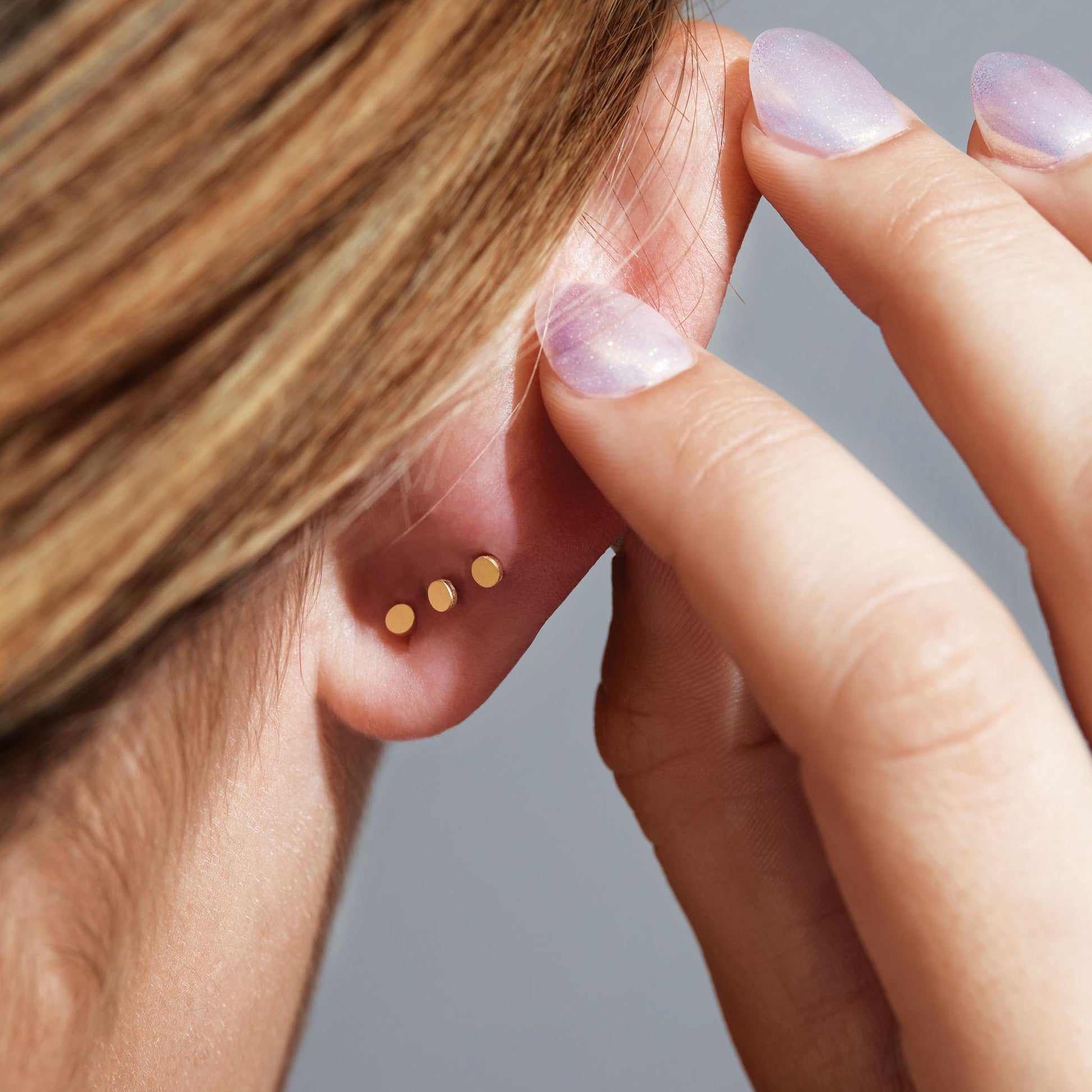
What Are Flatback Earrings?
Flatback earrings are a type of stud earring defined by their smooth, flush backing—unlike traditional earrings with butterfly or push-back closures that stick out from the ear. Instead of a protruding back, flatback earrings use a low-profile closure (often a screw-on or press-fit design) that lies flat against the skin, eliminating pressure, irritation, and snags. They’re primarily designed for comfort, making them ideal for sensitive ears, new piercings, or hard-to-reach spots like cartilage (helix, tragus, conch).
Flatback earrings trace their roots to medical-grade jewelry—originally used for healing piercings because their smooth backs reduce infection risk and irritation. Today, they’ve gone mainstream, with designs ranging from minimalist metal studs to gemstone-accented pieces that blend functionality with fashion.

Key Components of Flatback Earrings
Every flatback earring has three core parts that work together for comfort and security:
-
Front Piece: The visible part of the earring, which can be a stud (metal, gemstone, or enamel), a small hoop, or a dainty charm. It’s the “style” element—think a tiny diamond, a gold disc, or a colored gemstone.
-
Post: The thin metal rod that goes through the piercing hole. Unlike traditional posts (which are often thin and flimsy), flatback posts are usually thicker (16–18 gauge, standard for ear piercings) and made of hypoallergenic metals to prevent irritation.
-
Flat Backing: The closure that secures the earring in place. There are two main types:
-
Screw-On Back: A small, threaded backing that screws onto the end of the post. It’s secure (won’t fall off easily) and adjustable—you can tighten it to your comfort level.
-
Press-Fit Back: A tension-based backing that “snaps” onto the post (no threading needed). It’s faster to put on/take off but slightly less secure than screw-on (best for healed piercings, not new ones).
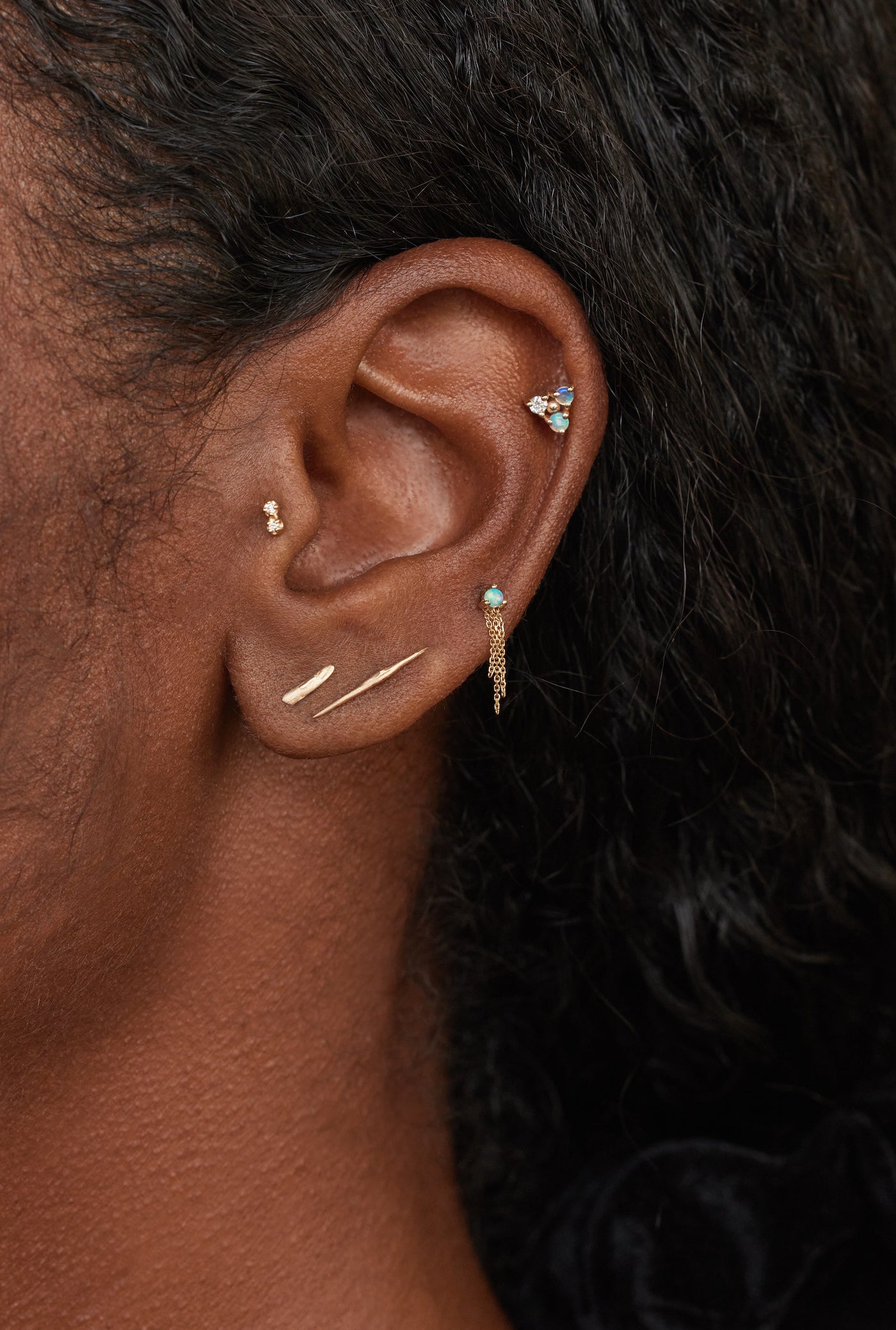
How Flatback Earrings Differ from Traditional Earrings
|
Feature |
Flatback Earrings |
Traditional Earrings (Butterfly/Push-Back) |
|
Backing Design |
Smooth, flush with skin |
Protruding (sticks out from ear) |
|
Comfort |
No pressure or irritation; won’t dig into skin |
Often causes discomfort with long wear; may dig into skin |
|
Snag Risk |
Low (flat back won’t catch on hair/clothing) |
High (protruding back snags easily) |
|
Best For |
Sensitive ears, new piercings, cartilage |
Healed lobe piercings, occasional wear |
|
Security |
Secure (screw-on/press-fit); rarely falls off |
Less secure (butterfly backs can loosen) |
Why Are Flatback Earrings So Popular?
Flatback earrings have skyrocketed in popularity because they solve the most common complaints people have about traditional earrings—while still delivering on style. Their appeal spans ages and piercing types, from teens with cartilage piercings to adults with sensitive lobes. Below are the key reasons they’ve become a jewelry staple:
Comfort for Sensitive Ears (and New Piercings)
The biggest draw of flatback earrings is their irritation-free design. Traditional earrings often use nickel-plated metals or protruding backs that rub against sensitive skin, causing redness, itching, or even infections. Flatback earrings, by contrast:
-
Are made of hypoallergenic metals (surgical steel, titanium, 14k gold) that don’t react with skin.
-
Have no protruding parts to dig into the back of the ear—ideal for people who wear earrings all day (e.g., office workers, students).
-
Are recommended by piercers for new piercings (healing takes 6–12 weeks for lobes, 3–6 months for cartilage) because their smooth backs reduce friction and infection risk.

No Snags, No Headaches
If you’ve ever torn a butterfly back out of your ear while brushing your hair or taking off a sweater, you know the frustration of traditional earrings. Flatback earrings eliminate this problem entirely: their flush backing sits tight against the skin, so it never catches on hair, clothing, or pillows. This makes them perfect for:
-
Active lifestyles (yoga, running, hiking—no earrings pulling mid-workout).
-
Daily wear (you can sleep in them without discomfort or risk of losing a backing).
-
Long hair (no more tangled strands around protruding backs).
Versatility for Every Piercing Type
Flatback earrings aren’t just for lobes—they’re designed to fit nearly every ear piercing, from cartilage to conchs. Their low-profile design works in tight spots where traditional earrings would feel bulky:
-
Cartilage (Helix/Tragus): The flat back fits comfortably against the curve of the ear, unlike traditional backs that stick out and irritate.
-
Conch: A deep inner-ear piercing—flatback earrings sit flush against the conch’s surface, avoiding pressure.
-
Lobe (Single or Stacked): Even for standard lobes, flatback earrings are great for stacking (wearing multiple studs close together) because their thin backs don’t overlap or feel bulky.

Sleek Style That Works for Any Outfit
Flatback earrings prove that comfort doesn’t mean sacrificing fashion. They come in endless styles—from minimalist metal studs to sparkly gemstones—so you can dress them up or down:
-
Casual: A tiny silver or gold flatback stud with a t-shirt and jeans adds subtle polish.
-
Work: A small diamond or pearl flatback earring keeps the look professional without feeling overdone.
-
Formal: A gemstone-accented flatback (think sapphire or ruby) pairs perfectly with a dress or suit for events.
Their understated design also makes them great for “invisible” style—small metal studs that add shine without drawing too much attention.
Popular Styles of Flatback Earrings
Flatback earrings come in a wide range of designs to match every taste, from minimalist to bold. Below are the most in-demand styles, organized by aesthetic and use case:
Minimalist Flatback Earrings (Everyday Essential)
These styles prioritize simplicity and versatility—perfect for daily wear or stacking:
-
Surgical Steel Basic Stud: A small, round or disc-shaped stud (3–5mm) made of surgical steel. Hypoallergenic and affordable, it’s ideal for new piercings or anyone who wants “no-fuss” jewelry. Great for lobes or cartilage.
-
14k Gold Tiny Disc: A thin, flat gold disc (2–4mm) with a screw-on back. The warm gold tone complements any skin color, and the tiny size is perfect for stacking (wear 2–3 in a single lobe or cartilage).
-
Titanium Bar Stud: A sleek, rectangular bar (5–7mm) made of titanium (the most hypoallergenic metal). It’s modern and edgy, great for teens or anyone who loves minimalist cool.
Gemstone-Accented Flatback Earrings (Sparkle & Color)
These styles add a pop of sparkle or color—ideal for special occasions or anyone who loves a little shine:
-
Diamond (or CZ) Solitaire: A small diamond (0.05–0.10 carats) or cubic zirconia set in a tiny metal bezel. The flat back keeps the focus on the gemstone, making it a subtle yet glamorous choice for dates or work parties.
-
Birthstone Stud: A colored gemstone (e.g., garnet for January, sapphire for September) in a round or oval cut. Personalized and meaningful, it’s a great gift for birthdays or anniversaries.
-
Enamel Pop: A small stud with a colored enamel front (e.g., black, pink, blue) and a metal flat back. Playful and affordable, it adds a fun touch to casual outfits (pair with a denim jacket or sundress).
Statement Flatback Earrings (Bold & Eye-Catching)
For when you want to make a subtle statement—these styles are slightly larger but still low-profile:
-
Huggie Flatback Hoop: A tiny hoop (8–10mm) that “hugs” the ear, with a flat back instead of a traditional hoop closure. It’s more versatile than a full-size hoop—great for cartilage or lobes.
-
Geometric Shape: A stud in a unique shape (triangle, star, heart) made of metal or enamel. The flat back keeps the shape from feeling bulky, so it’s bold but not overwhelming.
-
Two-Tone Design: A stud with two metals (e.g., silver and gold) or a metal front with a colored gemstone. It’s trendy and easy to mix with other jewelry (pair with a gold necklace or silver bracelet).
Healing-Focused Flatback Earrings (For New Piercings)
These styles are designed specifically for new or healing piercings (recommended by professional piercers):
-
Implant-Grade Titanium Stud: Made of medical-grade titanium (the least likely to cause irritation), with a smooth post and screw-on back. It’s thick enough to prevent the piercing from closing but thin enough for comfort.
-
Bioplast Flatback: A flexible, plastic post (biocompatible) with a metal flat back. It’s ideal for piercings that are still swelling (bioplast bends slightly, reducing pressure) and great for sensitive skin.
-
Crystal-Clear Flatback: A transparent acrylic or glass front with a titanium back. It’s “invisible” for healing piercings (great if you need to keep jewelry subtle for work/school) and hypoallergenic.
How to Wear Flatback Earrings
Wearing flatback earrings is simple, but there are a few tips to ensure they’re secure, comfortable, and styled to look their best—whether you’re wearing one pair or stacking multiple.
Putting Them On (Step-by-Step)
The process varies slightly by backing type (screw-on vs. press-fit), but here’s how to do it safely:
For Screw-On Flatbacks (Best for New/Healing Piercings)
-
Clean Your Hands & Earrings: Wash your hands with soap and water, then wipe the earring post and back with rubbing alcohol (to prevent infection).
-
Insert the Post: Hold the front piece (stud) between your thumb and index finger, and gently push the post through the piercing hole from the front of the ear to the back.
-
Secure the Back: Take the flat back in your other hand (use a tissue if it’s slippery) and screw it onto the end of the post. Turn it clockwise until it’s snug—but don’t overtighten (you should be able to move the earring slightly without it falling off).
-
Check Comfort: Make sure the back sits flat against your ear—if it feels tight or painful, loosen it a tiny bit (overtightening can irritate the piercing).
For Press-Fit Flatbacks (Best for Healed Piercings)
-
Align the Post & Back: Hold the front piece so the post is pointing backward, and line up the flat back with the end of the post.
-
Push to Secure: Gently push the back onto the post until you hear a small “click” (this means it’s locked in place).
-
Test Security: Tug gently on the front piece to make sure the back doesn’t come loose. If it slides off, push it on again with a little more pressure.
Styling Tips for Different Piercings
-
Lobe Piercings:
-
Single Stud: A medium-sized gemstone or metal flatback (4–6mm) works for a classic, polished look.
-
Stacking: Wear 2–3 tiny flatbacks (2–3mm) in a single lobe, spacing them 1–2mm apart. Mix metals (e.g., silver + gold) or stick to one for a cohesive vibe.
-
Cartilage Piercings (Helix/Tragus):
-
Use small, low-profile styles (3–5mm) to avoid pressure on the ear. A tiny diamond or metal stud is subtle but adds shine.
-
For multiple cartilage piercings (e.g., double helix), mix sizes: a 3mm stud and a 5mm huggie hoop flatback.
-
Conch Piercings:
-
Opt for a slightly larger stud (5–7mm) since the conch is a deeper piercing—this ensures the front piece is visible but the back still sits flat.
Pairing with Other Jewelry
Flatback earrings are easy to mix with other jewelry—just keep the focus on balance:
-
Necklaces: If you’re wearing a bold necklace (e.g., a chunky chain), stick to tiny flatback studs (2–3mm) so your ears don’t compete for attention.
-
Bracelets: Pair gold flatback earrings with a gold bracelet for a cohesive “set” look, or mix metals (silver earrings + gold bracelet) for a trendy vibe.
-
Other Earrings: If you have multiple piercings (e.g., lobe + helix), match the metal of your flatbacks to keep the look unified. For example: silver lobe flatback + silver helix flatback.
Flatback Earrings: Perfect Gift for Your Girlfriend
Flatback earrings are a thoughtful, practical gift for your girlfriend—they show you’ve paid attention to her needs (like sensitive ears or a love for low-maintenance jewelry) and want to give her something she’ll actually wear every day. Unlike generic gifts (e.g., candles, candy), flatback earrings are a lasting accessory that reminds her of you every time she puts them on.
Why It Resonates as a Girlfriend Gift
-
Solves a Problem: If she’s ever complained about uncomfortable earrings or lost a backing, flatback earrings fix that. It’s a gift that’s both thoughtful and useful—not just decorative.
-
Matches Her Style: Whether she loves minimalist jewelry, sparkly gems, or bold colors, there’s a flatback style for her. You can pick something that fits her vibe, showing you know her taste.
-
Wears Every Day: She won’t put these in a jewelry box and forget them—flatback earrings are perfect for daily wear, so she’ll get use out of them immediately.
Top Flatback Earring Gifts for Your Girlfriend
-
14k Gold Birthstone Flatback: A personalized choice—pick her birthstone (or the birthstone of a shared date, like your first anniversary) set in a tiny bezel. The gold is timeless, and the birthstone adds a personal touch.
-
Diamond (or CZ) Solitaire Flatback: A subtle luxury gift—small enough for daily wear (0.05–0.10 carats) but sparkly enough to feel special. Great for birthdays, anniversaries, or “just because” moments.
-
Minimalist Stackable Set: A set of 2–3 tiny metal flatbacks (e.g., 14k gold discs in 2mm, 3mm, 4mm sizes). She can wear them alone or stack them in her lobe or cartilage—versatile and trendy.
Tips for Choosing the Right Pair
-
Check Her Piercings: If she only has lobe piercings, any flatback style works. If she has cartilage (helix, tragus), pick a small, low-profile stud (3–5mm) to avoid discomfort.
-
Know Her Metal Preference: Does she wear silver, gold, or both? Stick to what she already loves—if she never wears silver, don’t buy silver flatbacks.
-
Consider Her Lifestyle: If she’s active (works out, hikes), go for a durable metal like titanium or surgical steel. If she prefers luxury, 14k gold is a safe bet.
How to Clean Flatback Earrings
Cleaning flatback earrings is easy—regular care keeps them shiny, prevents infection (especially for new piercings), and extends their life. The process is similar for most styles, but adjust based on whether the earrings are metal, gemstone, or for a healing piercing.
Weekly Deep Cleaning for Healed Piercings
Once your piercing is fully healed (6–12 months for cartilage), you can do a more thorough clean to keep the earring shiny:
-
Mix a Mild Solution: In a small bowl, combine 1 cup warm water with 1 drop of mild dish soap (like Dawn—avoid antibacterial or scented soaps, which can dry out the skin).
-
Soak the Earring (If Removable): For two-piece flatbacks, unscrew the flat back and remove the front piece. Soak both parts in the soapy solution for 10–15 minutes. For one-piece flatbacks, gently dip the front and back of the earring in the solution (do not submerge the piercing).
-
Scrub Gently: Use a soft-bristled toothbrush (designated for jewelry) to lightly scrub the front piece (especially if it has gemstones or crevices) and the flat back. This removes dirt and oil buildup that saline alone can’t eliminate.
-
Rinse and Dry: Rinse the earring parts under warm water to remove soap residue. Pat dry with a microfiber cloth, then reinsert (if removed) once fully dry.
Material-Specific Cleaning Tips
-
Surgical Steel/Titanium: These metals are durable—you can use the soapy water method weekly without damage. Avoid using metal polish, as it can leave a film on the earring.
-
14k Gold: Gold is soft, so avoid scrubbing too hard. Use a soft cloth instead of a toothbrush for gold flatbacks to prevent scratches. You can also use a gold-specific jewelry cleaner once a month to restore shine.
-
Gemstone/CZ Flatbacks: For gemstones like birthstones or CZ, avoid harsh chemicals. Use the soapy water method, and gently wipe gemstones with a cotton swab to clean around the setting.
How to Take Out Flatback Earrings
Taking out flatback earrings requires a bit of care (especially for threaded styles) to avoid irritating the piercing. Follow these steps based on the closure type:
Step-by-Step for Threaded (Screw-On) Flatbacks
Threaded flatbacks are the most secure but require patience to remove:
-
Wash Your Hands: Always wash your hands with antibacterial soap before touching your piercing—this prevents bacteria from entering the hole.
-
Stabilize the Front Piece: Use your index finger and thumb to gently hold the front piece of the earring (the stud or gemstone) in place. This keeps the post from spinning as you unscrew the back.
-
Unscrew the Flat Back: Use your other hand to grip the flat back. Turn it counterclockwise (to the left) to loosen it. If it’s tight (common for new piercings or earrings worn for a long time), you can use a clean paper towel for extra grip—avoid using tweezers, which can scratch the metal.
-
Remove Slowly: Once the back is loose, continue unscrewing it until it slides off the post. Then, gently pull the front piece out of the piercing hole—go slowly to avoid stretching or irritating the skin.
-
Clean Before Reinserting (If Needed): If you’re reinserting the earring later, clean both the front piece and flat back with saline solution first.
Step-by-Step for Push-In (Snap) Flatbacks
Push-in flatbacks are faster to remove but still require care:
-
Wash Your Hands: Same as above—clean hands prevent infection.
-
Stabilize the Front: Hold the front piece of the earring with one hand to keep it from moving.
-
Pull the Back Gently: Use your other hand to grip the flat back and pull it straight back (away from the ear) with gentle pressure. The back should “pop” off the post—do not twist or yank, as this can damage the closure.
-
Remove the Front Piece: Once the back is off, slide the front piece out of the piercing hole slowly.
Tips for Hard-to-Remove Flatbacks
-
For Stuck Threaded Backs: If the flat back is stuck, apply a tiny amount of petroleum jelly (like Vaseline) to the post where the back meets the metal. Let it sit for 1–2 minutes to lubricate, then try unscrewing again.
-
For New Piercings: Avoid removing new piercings (under 6 months old) unless instructed by a piercer. Removing them too early can cause the hole to close or become infected. If you must remove it (e.g., for a medical procedure), have a piercer help you.
-
For Sore Piercings: If your piercing is sore or swollen, wait until the discomfort subsides before removing the earring. If you need to remove it immediately, apply a warm compress for 5 minutes first to reduce swelling.
How Do Flatback Earrings Work?
Flatback earrings work by combining a low-profile design with a secure closure to eliminate irritation and stay in place—here’s a breakdown of their mechanics and why they’re different from traditional earrings:
Core Design Mechanics
-
Flush Back Component: The “flatback” itself is a smooth, disc-shaped piece of metal (usually 4mm–6mm in diameter) that sits directly against the skin behind the ear. Unlike butterfly backs (which have a 凸起 that rubs), the flat disc distributes pressure evenly, preventing soreness even after hours of wear.
-
Post and Closure System:
-
Threaded Systems: The post of the front piece has tiny, precision-cut threads (like a small screw). The flat back has a matching threaded hole—when screwed together, the threads create a tight seal that won’t slip loose, even during activity.
-
Push-In Systems: The post has a small, raised ridge near the end. The flat back has a hole with a slightly smaller diameter than the ridge—when pushed on, the ridge “snaps” into the hole, creating a secure (but removable) fit.
-
Piercing Compatibility: Flatback earrings are designed for piercings where space is limited (like cartilage). Their short posts (6mm–10mm) prevent the earring from sticking out too far, while the flat back ensures it doesn’t rub against the skull or hair.
Why They’re Better for Sensitive or New Piercings
-
Reduced Friction: Traditional earrings have moving parts (like butterfly backs) that rub against the piercing hole, causing irritation. Flatback earrings’ fixed, flush design eliminates this friction, letting the piercing heal faster.
-
Hypoallergenic Materials: Most flatbacks are made with surgical steel, titanium, or 14k gold—metals that don’t contain nickel (the most common cause of jewelry allergies). This makes them safe for even the most sensitive skin.
-
Minimal Movement: The secure closure keeps the earring from shifting in the piercing hole. For new piercings, movement can disrupt the healing tissue and cause “piercing bumps” (small, painful lumps)—flatbacks prevent this by keeping the post stable.
Frequently Asked Questions About Flatback Earrings
Q: Can I wear flatback earrings in my lobe piercings?
A: Yes! While flatbacks are most popular for cartilage, they work great for lobe piercings—especially if you have sensitive lobes or want extra comfort. Look for 18g or 20g flatbacks (thinner than cartilage styles) and shorter posts (6mm–7mm) to fit lobes perfectly. They’re also a great option for kids’ lobe piercings, as they’re less likely to get caught on clothing.
Q: How long can I leave flatback earrings in?
A: For healed piercings, you can leave flatback earrings in 24/7—even while sleeping or showering. Their secure closure and flush design make them safe for long-term wear. For new piercings (under 6 months), leave them in until the piercing is fully healed (your piercer will tell you when)—removing them early can cause the hole to close.
Q: Are flatback earrings compatible with all cartilage piercings?
A: Flatback earrings work for most cartilage piercings, including:
-
Helix (upper ear cartilage)
-
Tragus (small flap in front of the ear canal)
-
Daith (inner cartilage fold)
-
Conch (round cartilage in the center of the ear)
The only exception is very small piercings (like the snug), which may require extra-short posts (5mm)—check with your piercer to confirm the right size.
Q: Do flatback earrings ever fall out?
A: It’s rare for threaded flatback earrings to fall out—their screw-on closure is very secure. Push-in flatbacks may fall out if the closure is worn out (common after 6–12 months of use) or if they’re not pushed in all the way. To prevent this, inspect push-in closures monthly—if the back feels loose, replace it with a new one (most jewelers sell replacement backs for \(5–\)10).
Q: Can I get flatback earrings with different gemstone shapes?
A: Yes! Most jewelers offer flatback earrings with gemstones in shapes like round, princess (square), oval, or marquise. You can also find them with unique cuts (like pear or heart) for a more personalized look. For example, a princess-cut CZ flatback adds a modern edge, while an oval birthstone flatback feels more romantic.
Conclusion: Flatback Earrings—Comfortable Sparkle for Sensitive Ears
Flatback earrings have redefined what comfortable, stylish piercing jewelry can be—they eliminate the irritation of traditional earrings while delivering the sparkle and security you want. Whether you’re rocking a minimalist titanium stud in your helix, a birthstone flatback in your tragus, or gifting a pair of gold CZ flatbacks to your girlfriend, they’re designed to fit seamlessly into your life—no poking, no snagging, no discomfort.
From their hypoallergenic materials to their versatile styles, flatback earrings prove that jewelry doesn’t have to sacrifice comfort for style. Now that you know how to choose, clean, and wear them, it’s time to upgrade your piercing collection. Browse our curated selection of flatback earrings—from surgical steel basics to luxury gold gemstone pieces—and use code FLATBACK15 to get 15% off your first order. Whether you’re a piercing newbie or a seasoned ear stacker, flatback earrings are the comfortable, sparkly addition your jewelry box has been missing. Shop now and experience irritation-free style today!


